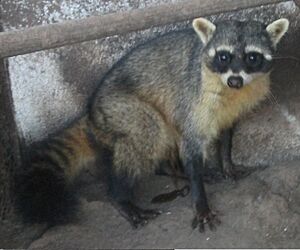Crab-eating raccoon facts for kids
Quick facts for kids Crab-eating raccoon |
|
|---|---|
 |
|
| An individual at Reserva de Fauna Carmelo, Uruguay | |
| Conservation status | |
| Scientific classification | |
| Genus: |
Procyon
|
| Species: |
cancrivorus
|
| Subspecies | |
|
|
 |
|
| Crab-eating raccoon range | |
The crab-eating raccoon (Procyon cancrivorus) is also known as the South American raccoon. This cool animal lives in wet, swampy, and jungle areas of Central America and South America. You can find them in countries like Costa Rica, Argentina, and Uruguay. They even live on the islands of Trinidad and Tobago.
Even though its name suggests it only eats crabs, this raccoon eats many other things too! Its northern cousin, the common raccoon, also enjoys crabs when it can find them. In Paraguay, people call the crab-eating raccoon aguará or agoará popé. These names come from the Guarani language.
Contents
Where Do Crab-Eating Raccoons Live?
The crab-eating raccoon makes its home across a large part of South America and some areas of Central America. They are found in many countries. These include Panama, Colombia, Venezuela, Brazil, and Peru. You can also find them in Ecuador, Bolivia, Paraguay, Uruguay, and Argentina. They also live in Suriname, Guyana, and French Guiana.
What Do Crab-Eating Raccoons Eat?
Crab-eating raccoons are omnivores, meaning they eat both plants and animals. Their favorite foods include crabs, lobsters, and crayfish. They also enjoy other crustaceans and shellfish like oysters and clams.
But their diet is much wider than just seafood! They also munch on small amphibians, fish, and insects. Sometimes, they eat small turtles and their eggs. Fruits, nuts, and vegetables are also part of their varied diet.
How Do Crab-Eating Raccoons Look?
The crab-eating raccoon looks a lot like its relative, the common raccoon. It has a fluffy tail with rings and a "bandit mask" of fur around its eyes. This mask makes them look a bit mysterious!
One way to tell them apart is by the fur on their neck. On a crab-eating raccoon, the fur on the back of its neck points towards its head. On a common raccoon, it points backward.
Body Features
Crab-eating raccoons are good at climbing trees. They have sharper, narrower claws that help them grip branches. Their teeth are also special. Most of their cheek teeth are larger and rounder than those of the common raccoon. This helps them crack open hard-shelled foods like crabs.
Even though they might look smaller, crab-eating raccoons are about the same size as common raccoons. Their fur is shorter, making them appear more slender. Their body length is about 41 to 80 centimeters (16 to 31 inches). Their tail can be 20 to 56 centimeters (8 to 22 inches) long.
They stand about 23 centimeters (9 inches) tall at the shoulder. Their weight can be anywhere from 2 to 12 kilograms (4 to 26 pounds). Most of them weigh between 5 and 7 kilograms (11 to 15 pounds). Male raccoons are usually bigger than females.
How Do Crab-Eating Raccoons Behave?
Crab-eating raccoons are mostly active at night, which means they are nocturnal. They prefer to live alone, so they are solitary animals. While they spend most of their time on the ground, they are also good at climbing trees.
You will almost always find these raccoons near water, like streams, lakes, and rivers. In places like Panama and Costa Rica, where both crab-eating and common raccoons live, they have different habitats. Crab-eating raccoons stick to inland rivers. Common raccoons prefer mangrove forests and swamps.
Crab-eating raccoons are not as comfortable around humans as common raccoons. They are less likely to live in cities or towns. They prefer wilder, less disturbed areas.
How Do Crab-Eating Raccoons Have Babies?
Crab-eating raccoons usually have their babies between July and September. The mother carries her babies for about 60 to 73 days before they are born.
Baby raccoons, called kits, are born in safe places. These can be cracks in rocks, hollow trees, or even old nests made by other animals. A mother raccoon usually has between two and seven kits, but three is the most common number.
Normally, a female raccoon will only have one litter of kits each year. However, if she loses all her babies early in the season, she might mate again. Then, she could have a second litter. Male raccoons do not help raise the young. When a mother is caring for her kits, she becomes very protective. She will not let other raccoons come near her or her babies.
Gallery
-
Drawing of a crab-eating Raccoon drawn between 1637–1644 by Frans Post
-
Skins of a common raccoon (left) and crab-eating raccoon (right)
See also
 In Spanish: Mapache cangrejero para niños
In Spanish: Mapache cangrejero para niños






